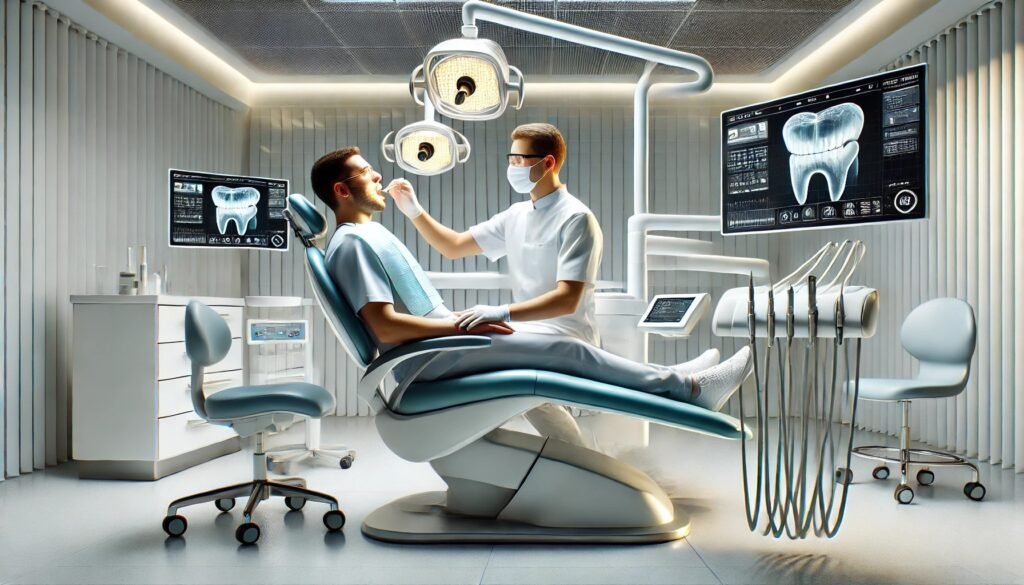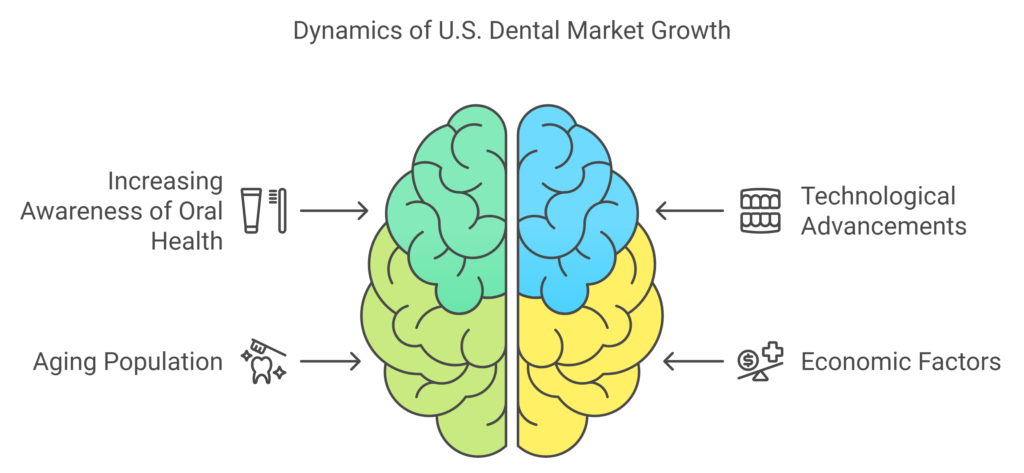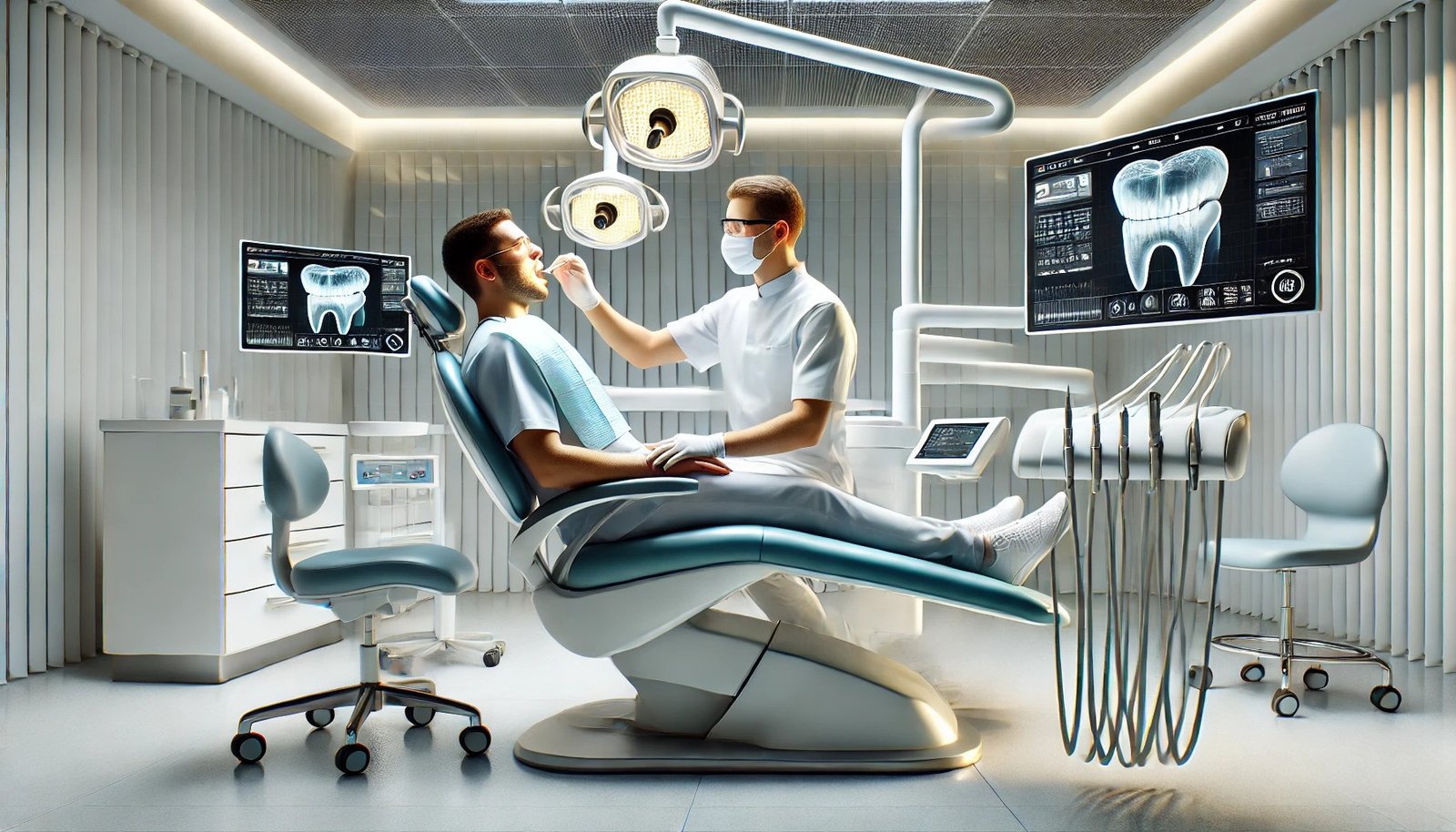Introduction to the U.S. Dental Services Market
The U.S. dental services market is a significant component of the country’s healthcare landscape, reflecting both the demand for dental care and the evolving nature of oral health services. As of 2023, this market is estimated to be valued at approximately $137 billion, demonstrating robust growth largely attributed to an increasing awareness of oral health and hygiene, advancements in dental technology, and a rise in dental insurance coverage.
Over the next decade, the market is projected to grow at a compound annual growth rate (CAGR) of around 5.6% from 2023 to 2033. This anticipated growth is influenced by several factors. One major element is the aging population, which tends to require more dental services due to age-related dental concerns. Furthermore, the growing emphasis on preventive care and aesthetic dentistry is leading to an increase in dental procedures that enhance both oral health and appearance.
In addition to demographic shifts, the incorporation of technology into dental practices plays a crucial role in market expansion. Innovations such as teledentistry, digital imaging, and 3D printing are transforming traditional dental services, enabling greater efficiency and improved patient experiences. These advancements are not only attractive to patients but also foster an environment conducive to practice growth and optimization.
The competitive landscape in the U.S. dental services market includes a diverse range of providers, from solo practitioners to large dental service organizations (DSOs). This variety allows for increased accessibility to care and heightened service offerings. As the market continues to adapt and expand, understanding these trends is critical for various stakeholders, including practitioners, investors, and policy-makers, to navigate the changing terrain effectively.

Market Size and Growth Projections
The U.S. dental services market has exhibited significant growth over the years, with its current valuation reaching approximately USD 155.68 billion in 2023. This remarkable size reflects not only the increasing demand for dental care but also the evolving landscape of dental services that are becoming more accessible to the general population. The projected growth of the market to around USD 260.49 billion by 2033 indicates a robust trajectory for the industry, characterized by a compound annual growth rate (CAGR) of 5.28%. Such growth underscores the vital role that the dental services sector plays within the broader healthcare ecosystem.
This expansion can be attributed to various factors, including an increasing awareness of oral health, advancements in dental technology, and a rise in disposable income among consumers. The dental services market encompasses a wide array of services, from routine check-ups and preventive care to specialized treatments such as orthodontics and cosmetic dentistry. These diversifications contribute to the sector’s appeal and growth potential as more people prioritize their oral health as an integral component of their overall well-being.
The significance of a 5.28% CAGR is particularly noteworthy, as it not only highlights the expected financial returns for businesses operating within the dental industry but also reflects a broader economic trend towards health investment. Furthermore, this growth is expected to create numerous job opportunities, sustaining employment for dental professionals and ancillary support staff alike. As competition within the dental services market intensifies, providers are increasingly adopting innovative practices and technologies to enhance patient experiences, which will further drive market expansion in the coming years.

Factors Driving Market Growth
The growth of the U.S. dental services market can be attributed to several key factors that underscore the increasing demand for oral health care. One prominent driver is the heightened awareness of oral health among the general population. As public campaigns and educational initiatives promote the importance of dental hygiene, more individuals are recognizing the impact of oral health on overall well-being. This shift in awareness has led to an increase in routine dental check-ups and preventive care, effectively expanding market demand.
Additionally, technological advancements have significantly transformed the dental landscape. Innovations such as digital imaging, tele-dentistry, and laser treatments have streamlined processes, improved patient experiences, and enhanced treatment outcomes. These technologies not only make dental procedures more efficient but also allow for a better, more accurate diagnosis and treatment plans. As dental practices adopt these technologies, they can attract a broader patient base, further contributing to market growth.
Another crucial factor is the aging population in the United States. As individuals age, they often experience a range of dental issues, making regular dental services crucial for maintaining oral health. This demographic shift is expected to drive significant demand for dental services, as older adults typically require more frequent and specialized care. Clinics that effectively cater to the needs of this aging population are positioned to experience considerable growth in the coming years.
Finally, favorable economic factors such as rising disposable incomes and increased access to insurance coverage play a vital role in the expansion of the dental services market. As more people can afford dental care, there is a corresponding increase in visits to dental professionals. This positive economic environment supports the overall growth trajectory of the U.S. dental services market, establishing a robust foundation for continued advancement.
Increased Awareness of Oral Health
The growing recognition of oral health as a vital component of overall well-being has significantly influenced the U.S. dental services market. Public health initiatives and educational campaigns have played a pivotal role in disseminating information regarding the importance of regular dental check-ups and preventive care. This increased awareness stems from a collective effort among various stakeholders, including health organizations, dental associations, and community programs, all dedicated to promoting oral hygiene and preventive practices.
One of the remarkable outcomes of these initiatives is the shift in consumer perceptions regarding dental care. Historically, many individuals viewed dental visits as a reactionary measure, only necessary when issues arose. However, educational campaigns have successfully transitioned this view, emphasizing the importance of routine check-ups and preventive care in maintaining oral health. By illustrating the link between oral health and systemic conditions—such as cardiovascular disease and diabetes—these programs have underscored that preventive care is not only beneficial but essential for overall health.
Moreover, community-focused outreach has significantly targeted children and families, fostering an early understanding of the importance of oral hygiene. Schools frequently integrate dental health programs that teach students about brushing, flossing, and nutrition while highlighting the significance of regular dental visits. These educational efforts not only empower children but also spread awareness among parents, consequently boosting the demand for dental services.
Social media and digital platforms have also augmented these efforts, allowing for more expansive reach and engagement. Informative content on platforms such as Instagram, Facebook, and YouTube has made dental health education more accessible, immediately informing a diverse audience about practices that contribute to long-term oral health. In light of this developing awareness, the U.S. dental services market is likely to continue its upward trajectory as consumers increasingly prioritize preventive care and regular dental check-ups.
Technological Advancements in Dental Services
The U.S. dental services market has seen significant transformations driven by technological advancements that enhance treatment quality and elevate patient comfort. One prominent example is digital radiography, which has replaced traditional film-based x-rays in many dental practices. This innovative technology not only reduces radiation exposure for patients but also provides immediate high-resolution images, allowing dentists to diagnose and plan treatments more effectively. The enhanced clarity of digital images aids in early detection of dental issues, thereby improving treatment outcomes and patient satisfaction.
Moreover, the shift toward laser dentistry marks another pivotal development in the sector. Lasers are now being employed for various procedures, including gum disease treatment, cavity detection, and teeth whitening. This minimally invasive approach significantly reduces pain and recovery time for patients compared to conventional methods. As lasers can focus precisely on the targeted tissue, the surrounding areas are often left undisturbed, which further enhances comfort and reduces the need for anesthesia. The ability to provide such advanced options has led to an increase in consumer interest, as patients are increasingly attracted to practices that offer cutting-edge technology.
In addition to improving clinical efficiency, these technological innovations are influencing the overall patient experience. Practices equipped with advanced diagnostic and treatment tools are perceived as more credible, fostering trust and loyalty among patients. As dental technology continues to evolve, it not only enhances the quality of the services offered but also plays a crucial role in expanding the market. The combination of efficiency, effectiveness, and enhanced patient comfort provided by these advancements is driving a positive trend in the U.S. dental services market, encouraging patients to seek dental care more proactively.
Aging Population Impact on Dental Services
The demographic landscape of the United States is undergoing significant transformation, notably due to the aging population. By 2030, it is projected that approximately 20% of the U.S. population will be aged 65 or older. This substantial increase brings with it a heightened demand for dental services tailored specifically to the needs of older adults. As people age, they often experience a decline in oral health, necessitating restorative treatments and specialized care. Such treatments include dentures, crowns, bridges, and periodontal therapies, all of which are crucial for maintaining oral function and overall quality of life.
The implications of this demographic shift are profound. Older adults typically have a higher prevalence of chronic conditions, which can exacerbate dental health issues. For instance, conditions such as diabetes and osteoporosis directly impact oral health, leading to complications that require immediate dental attention. Consequently, dental practices are increasingly adapting their service offerings to meet this growing demand. This includes integrating geriatric care principles into dental training programs, thus equipping dental professionals with the skills necessary to address the complexities of treating older patients.
Moreover, as the aging population continues to grow, there has been a notable increase in awareness surrounding the importance of preventive care and regular dental check-ups. Consequently, dental service providers are focusing on education initiatives aimed at older adults, emphasizing the prevention of dental diseases rather than solely addressing them. This shift towards preventive care not only enhances patient outcomes but also contributes to a more sustainable healthcare model. Understanding the needs of an aging population and adapting services accordingly will be essential for dental practices as they navigate the changes in the market brought about by demographic trends.
Economic Factors Affecting Market Accessibility
The accessibility of dental services in the United States has been significantly influenced by various economic factors, particularly rising disposable incomes and improved insurance coverage. As disposable incomes have increased over recent years, more individuals are finding themselves in a position to allocate funds towards dental care. This surge in financial capability is encouraging a broader segment of the population to seek essential dental services that may have previously been viewed as unaffordable. With enhanced financial flexibility, families are more likely to prioritize regular check-ups and preventative care, ultimately contributing to improved oral health outcomes.
Additionally, the expansion of dental insurance coverage has played a crucial role in market accessibility. Many employers now offer dental insurance as a standard benefit, thereby mitigating the cost barrier that previously deterred individuals from pursuing dental services. Improved insurance plans that include comprehensive coverage not only encourage individuals to maintain routine dental visits but also empower them to seek necessary treatments without the associated financial burden. This enhancement in insurance accessibility aligns with a growing recognition of the importance of oral health as an integral component of overall health.
The interplay of these economic factors is propelling growth within the U.S. dental services market. As access to affordable oral care continues to expand, a ripple effect is observed in the demand for various dental treatments. Moreover, the burgeoning middle-class population is gravitating towards elective and cosmetic procedures, which further opens avenues for dental service providers. In light of these changes, dental professionals are likely to encounter an evolving landscape characterized by an increasing willingness to invest in oral health. This progress reaffirms the notion that economic growth significantly contributes to enhanced market accessibility within the dental services sector.
Market Segmentation: Clinics and Dental Implants
The U.S. dental services market is notably diversified, primarily segmented into dental clinics and dental implants, which play distinct roles in catering to patient requirements. Dental clinics dominate the market, accounting for over 70% of the overall industry share. This significant portion underscores the reliance of consumers on traditional dental practices for routine care, preventive treatments, and comprehensive dental services. Various factors contribute to the growth of dental clinics, including the accessibility of services, a growing emphasis on oral health awareness, and the increasing acceptance of dental insurance among patients. Routine visits to these clinics for check-ups, cleanings, and general dental care remain prevalent, indicating their critical position in the market.
On the other hand, dental implants represent a significant and growing segment of the market, holding over 23% of the industry share. Their prominence can be attributed to the rising incidence of tooth loss due to various factors, including aging populations, periodontal issues, and lifestyle choices. Dental implants are considered an effective solution for replacing missing teeth, providing patients with both aesthetic and functional benefits. As consumers become more informed about the advantages of dental implants, investments in this area have surged, leading to enhanced product offerings and innovative techniques that address patient needs.
Both segments fulfill essential consumer demands: while dental clinics offer foundational care across a broad spectrum of services, dental implants cater to a more specialized need for tooth replacement. This bifurcation in the market showcases how different consumer requirements drive growth and service development within the dental services industry. As trends continue to evolve, both dental clinics and the dental implant sector will play pivotal roles in shaping the future landscape of oral health care in the United States.
Future Outlook and Trends in Dental Services
The U.S. dental services market is poised for substantial growth in the coming years, driven by a confluence of demographic shifts, advancements in technology, and evolving consumer preferences. One of the pivotal factors influencing this trajectory is the aging population, which necessitates an increased demand for dental care services. As the Baby Boomer generation continues to age, their oral health needs will expand, ultimately contributing to higher service utilization rates.
Moreover, technological innovations are reshaping the dental landscape, offering new avenues for enhanced patient care. Procedures that were once invasive are becoming less so due to developments such as laser dentistry and minimally invasive techniques. Furthermore, the rise of teledentistry, accelerated by the COVID-19 pandemic, has changed how patients interact with dental services, promoting accessibility and convenience. This trend not only caters to the (and is likely to remain popular) demand for remote consultations but also positions dental practices to efficiently handle a larger patient base.
Consumer behavior is also shifting, with a growing emphasis on preventative care and cosmetic dentistry. People are becoming increasingly proactive about their oral health, investing in services that promote long-term well-being. The incorporation of wellness-oriented initiatives, coupled with aesthetic treatments, is reinforcing a more comprehensive approach to dental healthcare. Additionally, as awareness of oral health’s connection to overall health increases, consumers are more inclined to prioritize regular visits and preventive measures.
As we examine the future of the U.S. dental services market, it is clear that this sector will experience a robust evolution. Market players will need to adapt to these changes whilst leveraging technology and addressing the growing demands of an informed consumer base. The combined impact of these trends suggests an optimistic outlook, setting the stage for dynamic growth in dental services.
Citations:
[2] https://media.market.us/dental-services-market-news/
[3] https://www.precedenceresearch.com/dental-services-market
[4] https://www.grandviewresearch.com/industry-analysis/us-dental-services-market-report
[5] https://www.sphericalinsights.com/reports/united-states-dental-market
Latest Posts:
- $6.6 Billion by 2033: Is the Aircraft Lighting Industry Flying Blind?
- $27.4 Billion by 2030: Are We Overlooking the Risks in the Operating Room Equipment Market?
- From $7.2 Billion to $10.8 Billion: What’s Driving the Growth of Undercarriage Components Market?
- U.S. Dental Market to Hit $260 Billion by 2033: What’s Driving the Growth?
- Bouncing Back Stronger: Strategies to Inspire Your Team After a Project Setback

